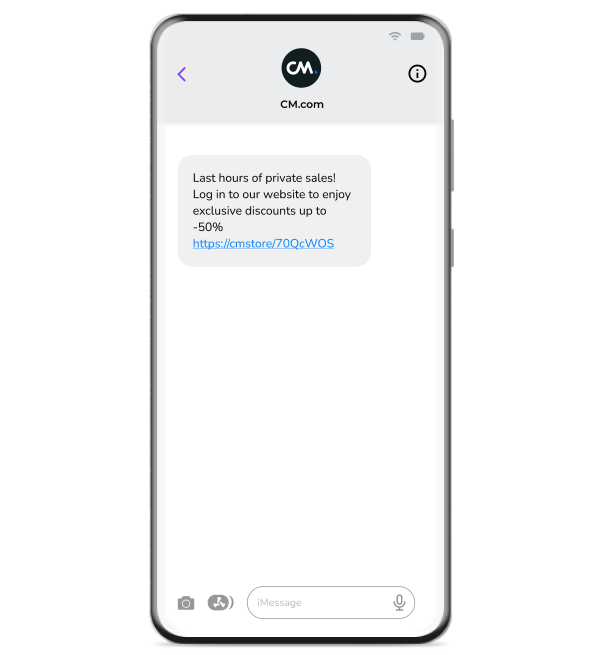What Is Mobile Marketing?
Mobile marketing applies the principles of marketing with a focus on mobile devices such as smartphones and tablets. Mobile Marketing aims to attract, engage, and communicate with customers via content, campaigns, and managed conversations via email, SMS, MMS, social media, and messaging channels.
Mobile marketing isn’t a separate field from conventional marketing. It uses the same marketing principles, like AIDA (attraction, interest, desire, action), and the same metrics, like conversion rates. And it has the same goals of engaging customers in sustained profitable relationships. Where it differs is the channels.
Mobile Marketing vs. Traditional Marketing
Traditional marketing ranges from large-format media like posters to smaller formats like desktop screens. Mobile marketing, however, assumes smaller real estate – the screens of phones, tablets, even watches – and customizes its approach and methods for mobile-focused channels like Short Message Services (SMS), Multimedia Message Service (MMS), mobile-optimized web pages and email inboxes, and communications platforms like WhatsApp and Facebook Messenger.

Mobile marketing also looks to engage the consumer across whatever channels they prefer (multichannel communication) and to connect all touchpoints across all channels into a single omnichannel customer experience.
Since these channels rely on different infrastructures (mobile networks, the internet, email services) connecting them into a unified messaging experience can be hard. To manage this, many mobile marketers use a mobile marketing platform such as CM.com’s Mobile Marketing Cloud.
Why Is Mobile Marketing Important?
Smartphone Use Is Now Universal
From zero a few decades ago, the number of active mobile devices in the world today far exceeds the number of people, at over 15bn – and growing at a billion a year. For many people, their phone is the primary device for interacting online across all channels.
A Broadening of Channel Choices
And with the proliferation of channels, the traditional use of a phone – voice – is fading. In the UK total voice minutes consumed per month started falling in 2018; the same picture is emerging worldwide. In addition, voice itself is spreading into other channels: both WhatsApp and Facebook Messenger (among others) let people chat to each other using voice as well as text, with such calls not showing up as voice on the consumer’s monthly bill.

The Mobile Phone Is the Primary Device
With smartphone use now at 83% even among the over-55s, and over 6bn smartphones in circulation, this means any marketer today must use mobile – or miss a vast section of their audience.
What Are the Different Types of Mobile Marketing?
As with traditional marketing, mobile marketing can answer different roles.
Maintaining brand awareness, by engaging customers in regular interactions
Building stronger customer relationships, with personalized and targeted content
Offering after sales service, with chatbots and customer service systems that maintain a brand’s reputation
Communicating special offers and promotions, with mobile vouchers, coupons, and discount codes
Offering location-based services, when customers are in a position to use a product or service now
Prompting and reminding, with messages that nudge consumers to complete a purchase or take up an offer
Cross-selling and up-selling, to maximize the value of each customer over his/her lifetime
Running membership programs, with apps or mobile-based content
Mobile form factors enable marketers to take advantage of opportunities not available on the desktop, such as scannable QR codes that make it easy to take up an offer, SMS Short Codes that respond with instant offers or benefits, and the ability to offer instant customer service from any location, with chatbots, two-way SMS, and links to location-based content.
What Are the Advantages of Mobile Marketing?
Mobile Devices are Always at Hand
A consumer’s phone is typically within 2m of them at all times, consulted 58 times a day on average; engagement with mobile devices is also high, averaging over 3hrs/day. This makes mobile marketing an effective means to contact, connect, and engage in conversations with consumers.
Privacy Legislation Reduces Abuse
With legislation like GDPR in use across Europe and its principles adopted worldwide, all legitimate marketers follow a code of conduct requiring opt-in to marketing messages (often double opt-in) and limits on the number of messages per day. This makes mobile marketing generally trusted and effective, useful to marketers without annoying their target audiences.
The Smartphone Is a Lean-Forward Device
Channels like TV and radio are “lean-back”; the consumer is passively absorbing content rather than interacting with it. The mobile phone and other mobile devices, however, are “lean-forward”: the consumer is goal-driven and actively engaged with a process. This makes mobile marketing ideal for goal-centric campaigns like driving sales or boosting audience participation.
Consumers Feel in Control
As a deeply personal device, consumers like to feel in control of their experience and choose how to respond. By offering a choice of communications channels – from simple text messages to full conversations mediated by AI – mobile marketers can address such customer desires, allowing them to build sustained relationships with personalized one-to-one content.
Interactions Can Be Tracked and Analyzed
Since each smartphone is generally owned by a single person (and rarely shared) the quality of data when tracking receives, opens, clicks, and actions across the customer journey can be very high. Mobile marketers make use of this data to customize communications for each individual and improve response rates to future marketing campaigns.
What Are Mobile Marketing Examples?
The best mobile marketing uses mobile channels and devices in ways a larger device (such as a desktop PC) cannot. This often means marketing campaigns make use of proximity, immediacy, and interaction.
A real-world ad can contain a scannable QR code that opens a mobile web page in the consumer’s phone
A customer service interaction started by SMS can cross channels into a chatbot window or WhatsApp conversation
An email can offer links to a phone support line or other voice option
Different locations in the real world can make different offers to the same consumer as he/she moves around, tailoring the offer to the situation
Successful mobile marketing campaigns make use of all these factors, stitching the customer experience together across channels while communicating with each customer individually. This is only possible, however, if the marketer treats all communications as part of a whole, using a mobile marketing software platform like CM.com.
How to Get Started With Mobile Marketing
CM.com offers many options to mobile marketers with the CM.com Mobile Marketing Cloud, a platform for omnichannel mobile marketing worldwide. It lets marketers unify their SMS, email, voice, and other mobile channels to offer consumers a seamless customer experience, whatever channel they prefer – and provides tracking and analysis tools that enable insights from their behavior.